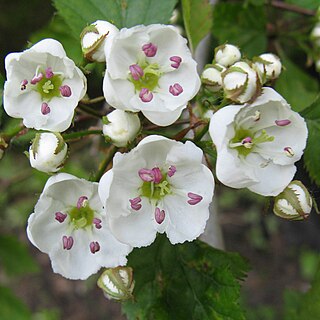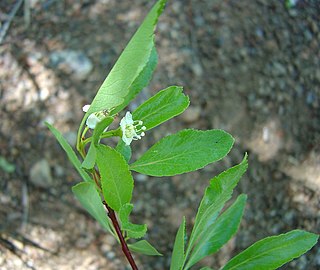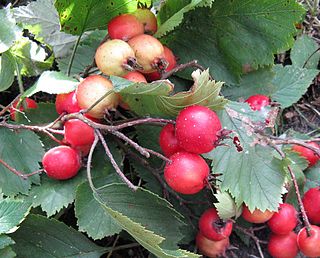
Crataegus, commonly called hawthorn, quickthorn, thornapple, May-tree, whitethorn, Mayflower, or hawberry, is a genus of several hundred species of shrubs and trees in the family Rosaceae, native to temperate regions of the Northern Hemisphere in Europe, Asia, North Africa, and North America. The name "hawthorn" was originally applied to the species native to northern Europe, especially the common hawthorn C. monogyna, and the unmodified name is often so used in Britain and Ireland. The name is now also applied to the entire genus and to the related Asian genus Rhaphiolepis.

Crataegus aestivalis, known as the eastern mayhaw, is a shrub or small tree of the southeastern United States that grows in low-lying or wet areas from eastern Alabama to central Florida and Virginia. It is one of several species of hawthorn with fruits known as "mayhaws", which are harvested for use in making mayhaw jelly, considered a delicacy in many areas of the South. Other species of mayhaws include Crataegus opaca, the western May Hawthorn, which is native from east Texas to Alabama.
The name Crataegus columbiana is a source of considerable confusion. The species named by Thomas J. Howell is now considered to be the same as C. douglasii, named earlier, and the earlier name should be used instead. However, some varieties of C. columbiana have also been named that are not related to C. douglasii. C. columbiana has been used by some authors for Crataegus piperiBritton, which is now known as C. chrysocarpa var. piperi.

Crataegus azarolus is a species of hawthorn known by the common names azarole, azerole, and Mediterranean medlar. It is native to the Mediterranean Basin and is a common plant there, growing on sites comparable to those the European common hawthorn grows on. In the Arab countries it is the most common hawthorn species. When growing in the wild, the azerole bears plentiful crops of haw fruits, which are similar to the haws of the European common hawthorn, but more plump.

Crataegus chrysocarpa is a species of hawthorn that is native to much of the continental United States and Canada. Common names fireberry hawthorn and goldenberry hawthorn, as well as the scientific name all refer to the colour of the unripe fruit, although the mature fruit is red and in var. vernonensis is "deep claret-colored … nearly black when over-ripe".

Crataegus crus-galli is a species of hawthorn known by the common names cockspur hawthorn and cockspur thorn. It is native to eastern North America from Ontario to Texas to Florida, and it is widely used in horticulture. It is thought to be the parent, along with Crataegus succulenta, of the tetraploid species Crataegus persimilis.

Crataegus flabellata is a species of hawthorn known by the common name fanleaf hawthorn. It is native to the northeastern United States and adjacent Canada. It is intermediate in appearance between C. macrosperma and C. chrysocarpa. C. macrosperma, which occurs throughout the range of C. flabellata and also in the southeastern U.S., is often misidentified as C. flabellata.

Crataegus holmesiana is a species of hawthorn closely related to Scarlet Hawthorn, C. coccinea, but with more elongated fruit and leaves.

Crataegus marshallii is a species of hawthorn known by the common name parsley hawthorn. It is native to the southeastern United States.

Crataegus pentagyna, also called small-flowered black hawthorn, is a species of hawthorn native to southeastern Europe. Two subspecies are recognized, C. p. subsp. pentagyna and C. p. subsp. pseudomelanocarpa. The fruit are usually black, but are sometimes a handsome purple.

Crataegus rivularis is a species of hawthorn known by the common name river hawthorn. It is native to the intermontane region of the northwestern United States, situated between the coastal ranges and the Rocky Mountains.

Crataegus saligna is a species of hawthorn known by the common name willow hawthorn that is seldom cultivated and rather rare in the wild. Its native range is wet areas of western Colorado and northeastern Utah. It is a shrub or small tree with thin, elongated leaves, small flowers, small black fruit, and reddish bark.

Crataegus submollis, known as the northern downy hawthorn, northern red haw, Quebec hawthorn, or hairy cockspurthorn, is a species of hawthorn that grows to about 7 m in height and typically carries large crops of red fruit.

Crataegus triflora is an uncommon hawthorn species of the south-eastern United States, of known by the common name three-flowered hawthorn.

Crataegus mexicana is a species of hawthorn known by the common names tejocote, manzanita, tejocotera and Mexican hawthorn. It is native to the mountains of Mexico and parts of Guatemala, and has been introduced in the Andes. The fruit of this species is one of the most useful among hawthorns.

Crataegus phippsii is a species of hawthorn native to south-central British Columbia, Washington state, and Montana. It forms a shrub or small tree to 7 m in height with leaves that have white hair on the underside, and fruit that ripen through red to purplish black. It appears to have potential as an ornamental plant.

Crataegus pennsylvanica, known as the Pennsylvania thorn, is a species of hawthorn native to Delaware, New York, North Carolina, Ontario, Ohio, and Pennsylvania, that grows to about 8 m in height. The mature trees have few thorns.

Series Molles is a series within the genus Crataegus that contains at least six species of hawthorn trees and shrubs, native to Eastern North America. Some of the species are cultivated as ornamental plants. They have relatively large leaves, large flowers, and bloom early for hawthorns. The plant parts are usually hairy, particularly in early growth, and the fruit are generally red and are large for hawthorn fruit.

Series Tenuifoliae is a series within the genus Crataegus that contains at least seven species of hawthorn trees and shrubs, native to Eastern North America, with one disjunct species in the mountains of New Mexico.
















